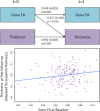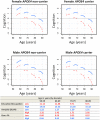Amyloid, Vascular, and Resilience Pathways Associated with Cognitive Aging
- PMID: 31509621
- PMCID: PMC6899909
- DOI: 10.1002/ana.25600
Amyloid, Vascular, and Resilience Pathways Associated with Cognitive Aging
Abstract
Objective: To investigate the multifactorial processes underlying cognitive aging based on the hypothesis that multiple causal pathways and mechanisms (amyloid, vascular, and resilience) influence longitudinal cognitive decline in each individual through worsening brain health.
Methods: We identified 1,230 elderly subjects (aged ≥50 years) with an average of 4.9 years of clinical follow-up and with amyloid positron emission tomography, diffusion tensor imaging, and structural magnetic resonance imaging scans from the population-based Mayo Clinic Study of Aging. We examined imaging markers of amyloid and brain health (white matter microstructural integrity and cortical thinning), systemic vascular health preceding the imaging markers, and early to midlife intellectual enrichment to predict longitudinal cognitive trajectories. We used latent growth curve models for modeling longitudinal cognitive decline.
Results: All the pathways (amyloid, vascular, resilience) converged through their effects on cortical thinning and worsening cognition and together explained patterns in cognitive decline. Resilience and vascular pathways (aging process, sex differences, education/occupation, and systemic vascular health) had significant impact on white matter microstructural integrity. Education/occupation levels contributed to white matter integrity through systemic vascular health. Worsening white matter integrity contributed to significant cortical thinning and subsequently longitudinal cognitive decline. Baseline amyloidosis contributed to a significant proportion of cognitive decline that accelerated with longer follow-up times, and its primary impact was through cortical thinning.
Interpretation: We developed an integrated framework to help explain the dynamic and complex process of cognitive aging by considering key causal pathways. Such an approach is important for both better comprehension of cognitive aging processes and will aid in the development of successful intervention strategies. ANN NEUROL 2019;86:866-877.
© 2019 The Authors. Annals of Neurology published by Wiley Periodicals, Inc. on behalf of American Neurological Association.
Conflict of interest statement
Nothing to report.
Figures





References
Publication types
MeSH terms
Substances
Supplementary concepts
Grants and funding
- C06 RR018898/GF/NIH HHS/United States
- R01 AG041851/AG/NIA NIH HHS/United States
- R01 AG056366/AG/NIA NIH HHS/United States
- R01 AG011378/AG/NIA NIH HHS/United States
- R37 AG011378/AG/NIA NIH HHS/United States
- U01 AG006786/AG/NIA NIH HHS/United States
- P50 AG016574/GF/NIH HHS/United States
- R01 AG034676/AG/NIA NIH HHS/United States
- R37 AG011378/GF/NIH HHS/United States
- ALZ/Alzheimer's Association/United States
- R01 AG034676/GF/NIH HHS/United States
- R01 NS097495/NS/NINDS NIH HHS/United States
- P30 AG062677/AG/NIA NIH HHS/United States
LinkOut - more resources
Full Text Sources
Medical

